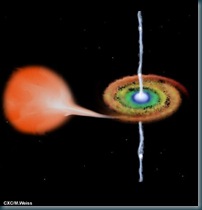My good friend sent an article about Innovation Feeder, which I really like, especially that he has added the comment - "look, here is something about you".
You can read the article here - Take me to your feeder
If you don't want to read it, just short definition:
"The definition of a “Feeder” is one who stimulates people’s minds with a constant supply of new trends & ideas. At least that’s how the big cheeses at Business Week define it. So how can you get around this in your own company?"
I visualize feeder as a black whole, which sucks information and data in any way possible, everything is interesting to her, because she can see or create connections with everything, going back and forward in time, also can "see" butterfly effect in progress, which is very interesting quality in itself. And as the black whole - after transformation and creation of new connections feeder spits out it back. She is not a walking encyclopedia, but concentrated shot of ideas, creative energy and motivation to try new things out.

These things do not come for free:
Feeders are usually very bad to put ideas in action, because as you have lots of them - there is no point to even try to do it. After all - why bother to do anything, if tomorrow you will have five new ideas about the same subject, which will be even better to implement? This requires some kind of discipline - very difficult for a Feeder. Or - Believers, who would be activated by her and try to achieve something real.
Sometimes, if not all the times Feeder explanations of things or ideas are so bizarre that you cannot get the point (which usually exists, but you need to have lots of background information to really grasp it). That means that good Feeder needs to learn how to present his ideas clearly, which is difficult task in itself and gets her to spend huge amount of time to gather any method possible to understand how to do it perfectly and in the process creates even more ideas (that usually are not related to the subject at all, at least not to any external observer).
It is difficult to focus for a Feeder on one task for longer time than five seconds (to write this post it took me about two hours), so they have to use some means to make things happen. For example - work on seven things simultaneously and dedicated short time period at a time in a round robin fashion. At first it is very difficult to get back to the task you have started and makes Feeder unhappy, but with time it becomes a habit, which can be useful.
Probably there are more issues, will try to come back to them later - have other six matters to attend now...
